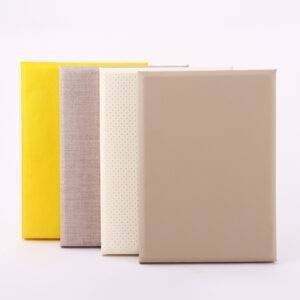Have you ever thought about investing in soundproofing for your home or commercial property? In many cases, finding the ideal soundproofing solutions can understandably seem like a struggle, leaving us unsure of where to turn. However, you could consider plenty of different materials, and soundproofing foam is just one example.
With this thought in mind, it’s no surprise that many people use soundproof foams for their development. However, it’s crucial to consider the benefits that soundproofing foam could deliver and whether these might match your needs. Luckily, we’ve outlined everything you need to know about soundproof foams as follows to help inform your decision.
What Is Soundproofing Foam?
Before we go any further, we first need to outline what soundproofing foam is. Soundproofing foam, as the name suggests, is a specialist type of foam designed to provide effective soundproofing benefits for your property.
Soundproofing foam, as with other types of insulating foam, is typically sprayed from a pressurized canister or the like. Then, this foam rapidly solidifies and hardens. Once the foam has hardened, it can then provide effective soundproofing for your property.
You can readily apply soundproofing foam onto a flat surface to fill a space (for example, the space between beams). However, in many cases, construction teams will instead apply soundproofing foam into a cavity. This fills the cavity entirely with soundproofing foam, substantially reducing the amount of sound that can pass through.

The Pros and Cons of Soundproof Foams
Soundproof foams offer numerous benefits, and considering these is important to decide whether these materials might match your needs. However, it’s always crucial to consider the negatives as well to choose the most effective solutions for your property.
Benefits of Soundproof Foams
Investing in a valuable soundproofing for your property can be incredibly difficult. However, if this is something you have been struggling with, the following benefits are worth considering:
- Soundproofing foam doesn’t disturb the aesthetic or design of your home. Since soundproofing foam is usually used to fill cavities, it’s completely out of sight for you and your guests. In turn, this ensures your home looks as good as usual, despite soundproofing.
- Soundproofing foam is incredibly effective for absorbing sound waves and preventing them from passing through. This provides incredibly effective privacy.
- While soundproofing foam is designed to block sounds, it’s also highly practical to reduce echoing. As such, it can help enhance sound quality significantly.
- Soundproofing foams are exceptionally effective for use during building and construction projects. They are easy to apply while the property is being built.
- A further benefit of soundproofing foams is that they’re highly affordable and quick to install. Since the soundproofing foam will expand to fill the available space, it’s highly effective for achieving full coverage of the available space.
These benefits could make soundproofing foams valuable for a wide array of potential applications. However, before you immediately invest in soundproofing materials, we’d recommend considering the drawbacks to see if they’re still a practical option.
The Main Drawbacks of Soundproofing Foam
While soundproofing foam is highly beneficial in many scenarios, it’s not a perfect solution for every property. As such, when deciding whether soundproof foams are right for you, the following drawbacks are vital to consider.
- Installing soundproofing foam is most practical when this is done at the same time as completing the construction project. Applying soundproofing foam after the walls are sealed may require you to dismantle any coverings. This can leave you struggling to achieve good coverage of the wall accordingly.
- Soundproofing foams cannot prevent fire from spreading, which may put your home or business at greater risk compared to some other surfaces.
- Soundproof foam is only effective if full coverage is achieved. If you cannot fully cover the space, you might notice that soundproof foams still allow a large amount of sound to pass through. You’ll also need a suitably thick covering since soundproofing foam is not very dense in its own right.
With these drawbacks in mind, it’s always important to ask: are soundproofing foams right for your home? If not, don’t panic – there are other soundproofing materials available that could work.

What’s the Alternative to Soundproof Foams?
At this point, we have outlined some of the key things you need to know about soundproofing foams and how these points might impact your final choices for soundproofing. However, it’s not the only choice of soundproofing material by a long shot. In fact, there are actually many different types of soundproofing materials.
As such, if you’re not sure that soundproof foams are right for you, other options – such as acoustic panels – might be more valuable. Luckily, our experts here at Dayin Acoustics can help with this.
Acoustic panels are one of the most common alternatives to soundproofing foam. And let’s be honest; there’s a lot to love about acoustic panels! They are among the most effortless solutions to install in your home. Moreover, you’ll also notice that acoustic panels are often designed with aesthetics in mind, providing a pleasing style for your home or business without compromising on practicality.
If you’re still unsure about the right choice of soundproofing materials for your needs, you could alternatively consider a soundproofing acoustic foam panel instead. These combine the benefits of both materials, making them exceptionally popular for soundproofing purposes.
Final Thoughts
If you’ve ever wondered about the benefits that soundproofing foam can deliver, we hope today’s guide will have helped. However, it’s important to consider that, in many cases, soundproof foams require very careful application. They’re also not overly good for use after the original construction project. This means that if your property’s walls are already sealed, you may struggle to use soundproofing foams without sacrificing a lot of space in your rooms.
With this thought in mind, acoustical panels can offer highly valuable, reliable, and effective solutions that combine practicality with effective support. So, why not give them a try if you’ve been looking for a simpler soundproofing solution?
For further questions, please contact us at dayin@dayinacoustics.com.



